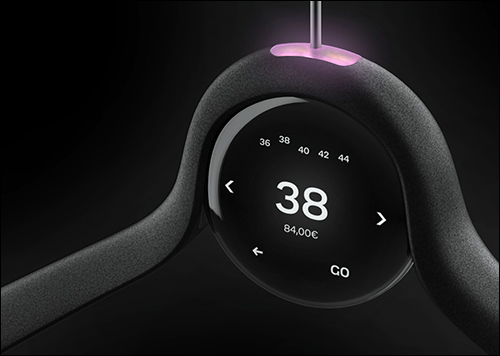French technology company BlueGriot is commercializing a Near Field Communication (NFC)-enabled in-store display hanger that captures data about the clothes hanging on it, then displays that data on a built-in screen, thereby sharing information about the product and any related sizes and styles available at the store. By using dual-frequency RFID tags, stores can capture both UHF RFID data for inventory management, as well as NFC RFID data for the consumer experience.
The solution can automatically detect which item is hanging on a hanger and link that information to UHF-based inventory data regarding what other garments are in stock. Thus, shoppers can better understand what clothing items are available without having to seek out a salesperson for help or pull out a phone to look up products available for sale online.
The solution was developed for Galeries Lafayette, located on Paris’s Avenue des Champs-Élysées, to let shoppers quickly access the right size, style or color of a product they would like to try on, while a minimal number of garments are actually on display. The store is using 2,000 hangers on its first floor (see IoT Companies Moving to Open Standards). Bluegriot is now in conversations with several luxury clothing brands that may pilot the technology as well.
Galeries Lafayette describes the smart hanger-based display at its store as a way to reinvent the customer experience. Instead of customers having to search through display products to find the right color and size, says Rudy Houque, Bluegriot’s founder, that effort can be done for them with the help of the hanger. According to Houque, the retailer sought a technology-based solution that would identify stock availability for each garment, then share that information and other product details with shoppers.
Bluegriot was launched three years ago to create smart objects, with a team of electronic and mechanical engineers, industrial designers and software developers, in order to build custom Internet of Things (IoT)-based solutions for industrial, medical and retail solutions. It provided sensors for traceability with GPS, while also working with microphones and accelerometers to manage how a machine is operating and when a failure could be imminent. In addition, the system is being designed for medial solutions, to track how individuals sleep. More recently, the company designed software to manage data derived from the hardware
For this retail deployment, the IoT startup began working to develop a hanger. The firm opted to use RFID for its ability to uniquely identify products. There was already an RFID label on each item, however, to enable inventory and supply chain management. The store, like many others, was receiving UHF RFID tags already attached to products from brands, and it was using that data to manage its own inventory. However, Houque says, UHF wouldn’t work with the hanger. A UHF reader would be too expense and would consume considerable energy, he notes, so the 13.56 MHz HF frequency was required. Ultimately, the company opted for NFC technology compliant with the ISO 14443 standard.
The solution changes the model of RFID use, Houque says. Each dual-frequency tag comes with one EM Microelectronic chip with two antennas—one HF and the other UHF. That required the firm to rethink the existing process, since UHF tags are already attached to products. Thus, Galeries Lafayette began printing a new UHF and HF label with a dual chip as each new clothing item arrived. Currently, he explains, that task is accomplished at the store. In some cases, the UHF tag might need to be removed, or it could be a complimentary tag.
The Bluegriot software links the tag’s unique ID number with the corresponding garment. “Each hanger needs to recognize the clothes it is wearing,” Houque says, and it does so via a built-in reader and STMicroelectronics‘ ST25R 3911b NFC reader chip. The device at the center of the hanger is about the size of a hockey puck and includes the reader and a battery. It also comes with a Nordic Semiconductor NRF52840 chip that complies with the Thread Group‘s open standard to send mesh-based transmissions via the 802.15.4 protocol.
Typically, a shopper picks up a hanger on which an item of clothing is displayed. The hanger’s built-in motion sensor detects that movement, after which the reader reads the garment’s tag ID and the LED screen automatically displays the product’s size and price. If the customer wishes to try on a different size or style, she or he can touch a prompt in the hanger display, along with the prompt for the fitting room. The hanger uses the Thread connection to forward that request to the server, and the software sends a message to the in-store sales associate, indicating which item to retrieve and take to a fitting room.
At Galeries Lafayette, stock is being stored in a dedicated area, while UHF RFID antennas are installed to track inventory as it arrives at and leaves that area. Those readers and antennas were deployed by other technology companies. The UHF inventory data can be integrated into the Bluegriot system.
The hanger enables shopper to spend more time trying on garments, Houque says, and less time looking through a cluttered store. Providing content on the hanger’s screen keeps shoppers from feeling they need to use their phones to search for products they don’t see in front of them. Retailers, he adds, do not want the shopping experience to be on a smartphone, in part because many shoppers are tourists from other countries that would not want to download an app.
The smart hanger solution is still at the pilot stage. However, Houque says, Bluegriot is currently speaking with other luxury apparel retailers and brands about using a similar solution.



